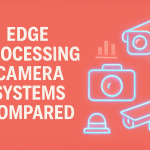Last Updated on September 7, 2025 by Dtechunt
The computing paradigm continues its decisive shift from centralized cloud architectures toward distributed emerging edge processing technologies. As of 2025, edge computing has evolved far beyond simple data preprocessing to become a sophisticated ecosystem of specialized hardware, AI algorithms, and communication protocols designed to process complex workloads at the source of data generation.
According to IDC’s latest forecast, global spending on edge computing is projected to reach $317.8 billion by 2026, growing at a 16.1% CAGR. This remarkable growth is fueled by several converging factors: explosive data volume growth, increased demand for real-time processing, stringent privacy regulations, and the emergence of transformative technologies that we’ll examine in this comprehensive analysis.
Neuromorphic Computing: Biology-Inspired Edge Processing
Traditional computing architectures—even those optimized for AI—still struggle with the energy efficiency and adaptability of biological neural systems. Neuromorphic computing addresses this limitation by fundamentally restructuring computing architecture to mimic brain function.
Breakthrough Developments
Intel’s Loihi 3 neuromorphic chip significantly advances with its 15 billion synthetic neurons and remarkably low power consumption. According to Intel’s research publications, these chips achieve AI inference tasks with 1/25th the energy of conventional processors while demonstrating superior performance on temporal pattern recognition tasks critical for edge applications.
Similarly, BrainChip’s Akida neuromorphic processor has gained notable traction for ultra-low-power edge deployments in smart cities, security systems, and automotive applications. The technology’s ability to learn continuously from sensory data without requiring retraining represents a fundamental advantage for edge deployment.
Practical Applications
The real-world impact of neuromorphic computing at the edge is becoming increasingly apparent:
- Autonomous vehicles using neuromorphic vision systems can identify obstacles and make navigation decisions with dramatically lower power requirements, extending electric vehicle range
- Smart infrastructure sensors can perform continuous monitoring and anomaly detection for years on a single battery
- Medical wearables can process complex biomarkers locally with minimal power consumption
As we noted in an analysis of edge AI efficiency metrics, “Neuromorphic architectures achieve up to 98% energy reduction compared to traditional computing approaches for equivalent inference tasks, fundamentally changing deployment economics.”
Federated Learning: Collaborative Intelligence While Preserving Privacy
Privacy concerns and regulatory requirements have created significant barriers to traditional AI development, which typically requires centralizing massive datasets. Federated learning has emerged as a breakthrough solution that enables collaborative model training while keeping sensitive data local.
Technical Evolution
Google’s Federated Learning of Cohorts (FLoC) initially introduced these concepts, but 2025 has seen substantial evolution in federated approaches:
- Cross-device federation protocols now support heterogeneous edge hardware with varying computational capabilities
- Differential privacy integration provides mathematical guarantees against data reconstruction attacks
- Compressed model updates reduce bandwidth requirements by up to 98%, enabling implementation on bandwidth-constrained IoT devices.
According to the Open Federated Learning Foundation, adoption has grown 385% in the past 18 months alone, driven by both privacy advantages and reduced cloud computing costs.
Industry Applications
Several sectors are leading federated learning adoption at the edge:
- Healthcare networks collaboratively train diagnostic models across institutions without sharing protected patient data
- Financial services improve fraud detection algorithms without exposing sensitive transaction details
- Smart home ecosystems enhance user experience while keeping behavioral data strictly local
As highlighted in the review of privacy-preserving machine learning, “Federated systems represent the future of responsible AI development, reconciling the competing needs for data-hungry models and stringent privacy protection.”
Edge-Native AI Frameworks: Purpose-Built for Distributed Intelligence
The limitations of simply compressing cloud-based models for edge deployment have become increasingly apparent. In response, a new generation of edge-native AI frameworks has emerged, designed from the ground up for distributed deployment.
Leading Frameworks
Several frameworks are gaining significant adoption:
- TensorFlow Lite Micro has evolved substantially from its origins, now supporting dynamic network reconfiguration based on available resources
- ONNX Runtime Edge provides cross-platform compatibility with exceptional optimization for heterogeneous computing environments
- Edge Impulse has expanded beyond microcontrollers to support sophisticated distributed training and inference pipelines.s
According to Gartner’s analysis, organizations deploying edge-native frameworks report 68% faster development cycles and 44% lower maintenance costs compared to adapted cloud frameworks.
Architectural Innovations
The most significant advancements in edge AI frameworks include:
- Dynamic precision adaptation that automatically adjusts numerical precision based on task requirements and available hardware
- Distributed neural architecture search that optimizes model topology across heterogeneous edge devices
- Federated continual learning that enables models to continuously improve while preventing catastrophic forgetting
In comparison of edge AI frameworks, we found that “Purpose-built edge frameworks deliver up to 73% better performance-per-watt than adapted cloud frameworks, fundamentally changing deployment economics.”
Advanced Edge Hardware: Beyond General-Purpose Computing
While software frameworks continue evolving, perhaps the most dramatic advancements are occurring in specialized edge hardware. The one-size-fits-all approach of general-purpose processors is giving way to highly specialized computing architectures.
Custom Silicon Evolution
Arm’s Project Centauri has established a comprehensive ecosystem for IoT-specific processors, emphasizing security, efficiency, and standardized software interfaces. These specialized designs achieve performance-per-watt figures that would be impossible with general-purpose architectures.
Similarly, Google’s Edge TPU has expanded beyond its initial focus on inference to support on-device training for specific applications. This capability enables continuous model improvement without cloud connectivity requirements.
Composable Computing Architectures
Perhaps most importantly, modular hardware approaches are gaining traction that enable runtime reconfiguration based on current workload requirements:
- Software-defined hardware that can reconfigure logic blocks on demand
- Heterogeneous computing clusters that intelligently route workloads to specialized accelerators
- Energy-aware task scheduling that optimizes for battery life in mobile edge applications
The Khronos Group’s OpenCL 3.0 standard has played a critical role in enabling software to efficiently utilize these heterogeneous computing resources.
Secure Edge Computing: Hardened Against Sophisticated Threats
As edge systems handle increasingly sensitive data and control critical infrastructure, security has become paramount. Traditional IT security approaches prove insufficient for the unique constraints and threat landscape of edge computing.
Hardware Security Innovations
Several breakthrough hardware security technologies have reached maturity:
- Physical Unclonable Functions (PUFs) provide a cryptographically secure device identity without storing keys
- Trusted Execution Environments (TEEs) create isolated processing regions immune to operating system compromise
- Post-quantum cryptography acceleration prepares edge systems for the quantum computing threat
The National Institute of Standards and Technology (NIST) has accelerated the standardization of post-quantum cryptographic algorithms specifically optimized for resource-constrained edge devices.
Zero-Trust Architectures for Edge
Traditional security perimeters have disappeared in distributed edge deployments, driving adoption of zero-trust security models:
- Continuous authentication that verifies device and user identity throughout interaction sessions
- Fine-grained authorization that limits access to the minimum necessary resources
- Attestation chains that cryptographically verify software integrity from the bootloader to the application
According to Forrester Research, organizations implementing zero-trust edge architectures report 79% fewer successful breaches compared to traditional security approaches.
5G/6G Integration: The Communication Backbone of Edge Computing
Advanced edge processing requires equally advanced communication capabilities. The integration of edge computing with 5G—and emerging 6G technologies creates synergies that enhance both paradigms.
Multi-access Edge Computing (MEC)
The European Telecommunications Standards Institute (ETSI) has driven the standardization of Multi-access Edge Computing, placing processing resources directly within the telecommunications infrastructure. This architecture achieves sub-5ms latency for time-critical applications while reducing backhaul bandwidth requirements.
Major deployments include:
- Smart city infrastructure processes real-time traffic and environmental data
- Industrial automation supporting time-sensitive networking requirements
- Augmented reality networks delivering immersive experiences through distributed rendering
6G Research Directions
Though commercial deployment remains years away, 6G research initiatives are focusing heavily on edge computing integration:
- Joint communication and sensing that unifies radar, imaging, and data transmission
- Terahertz communication enabling ultra-high-bandwidth short-range data transfer
- Distributed intelligence that dynamically allocates processing across the network based on current conditions
These technologies promise to fundamentally transform edge computing capabilities in the latter half of the decade.
Homomorphic Encryption: Processing Encrypted Data at the Edge
Traditional encryption approaches require decryption before processing, creating vulnerability windows. Homomorphic encryption (HE) represents a paradigm shift by enabling computation directly on encrypted data.
Practical Implementations
While complete homomorphic encryption remains computationally intensive, specialized implementations have become practical for specific edge use cases:
- Privacy-preserving analytics performing statistical operations on encrypted user data
- Secure multi-party computation enabling collaboration without revealing sensitive inputs
- Encrypted machine learning inference protects both model and input data
As noted in the examination of encryption technologies for edge privacy, “Partial homomorphic encryption now operates with only 3.5x overhead on specialized hardware, making it viable for many privacy-sensitive edge applications.”
Standardization Efforts
The Homomorphic Encryption Standardization Consortium has made significant progress in establishing interoperable standards, critical for widespread adoption. These efforts focus particularly on implementation optimizations for resource-constrained edge devices.
Real-World Impact: Edge Computing Transforming Industries
The convergence of these emerging edge technologies is creating transformative capabilities across multiple sectors:
Healthcare
Edge computing is revolutionizing healthcare delivery through:
- Continuous health monitoring with local processing of sensitive biometric data
- Real-time diagnostic support for emergency responders and rural clinicians
- Hospital equipment optimization through predictive maintenance and usage analytics
According to Healthcare IT News, healthcare organizations implementing edge computing report 47% faster diagnostic times and 23% reduced bandwidth costs.
Industrial Applications
Manufacturing and industrial sectors have embraced edge technologies for:
- Predictive maintenance detects equipment anomalies before failure
- Quality control automation through computer vision inspection
- Supply chain optimization via real-time tracking and condition monitoring
The World Economic Forum reports that edge-enabled factories demonstrate 17-20% higher operational efficiency and 30% lower maintenance costs.
Smart Cities
Urban environments are being transformed through:
- Intelligent traffic management responding to real-time conditions
- Public safety enhancements through privacy-preserving video analytics
- Environmental monitoring, optimizing resource usage, and detecting hazards
The United Nations ITU Focus Group on Smart Sustainable Cities has highlighted edge computing as an essential component for achieving sustainable development goals in urban environments.
Conclusion: The Transformative Potential of Emerging Edge Technologies
The convergence of neuromorphic computing, federated learning, advanced edge hardware, and secure processing technologies represents nothing less than a fundamental restructuring of our computing paradigm. As processing moves increasingly toward the edge, we can expect dramatic improvements in privacy, latency, reliability, and energy efficiency.
Organizations must develop comprehensive edge strategies that address not only the technical aspects of deployment but also the governance, security, and operational considerations. Those failing to embrace these emerging edge technologies risk falling behind competitors who leverage these capabilities to deliver superior products and services.
As we noted in our recent DTechunt edge computing adoption guide, “Edge computing has transitioned from emerging technology to essential infrastructure. The question is no longer whether to implement edge processing, but how to optimize architecture for maximum competitive advantage.”
The future of computing lies increasingly at the edge, and the technologies we’ve analyzed represent the leading edge of this transformative wave.



